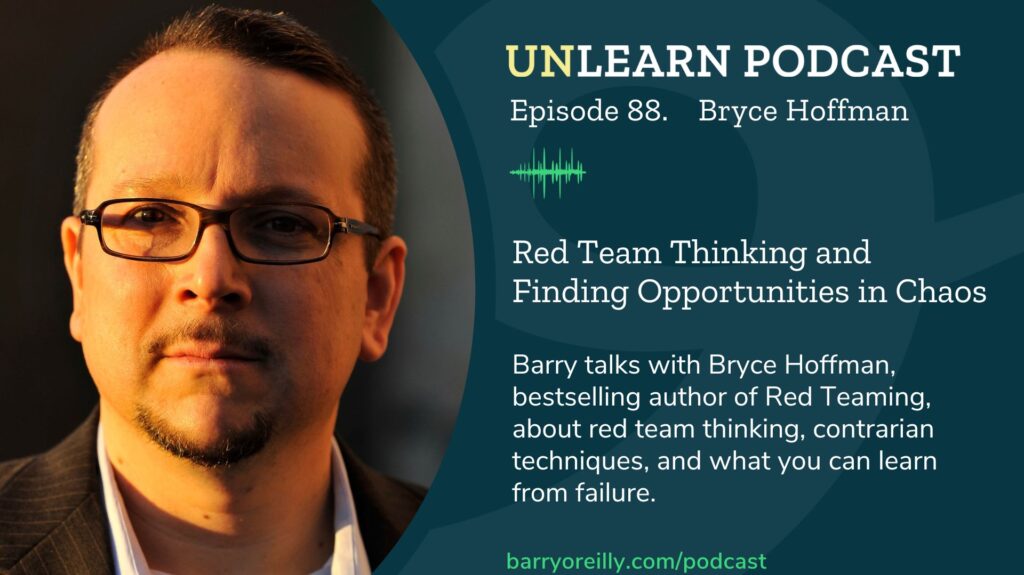Bryce Hoffman is a bestselling author, speaker, and unconsultant who believes that individuals have the power to transform companies and cultures through great leadership and applied critical thinking. He is one of the world’s foremost experts in decision-support red teaming, a revolutionary methodology inspired by the US military and intelligence agencies to help leaders make better decisions in today’s complex and rapidly changing world. In this episode of Unlearn, Bryce and Barry O’Reilly explore red team thinking, contrarian techniques and what you can learn from failure.
Getting Started
Bryce describes his experience writing his first book, American Icon. One day, after sending the meatier chapters to his editor, they called him and encouraged him to think about what consultant practice he would launch along with the book release. “I said, ‘What? I’m trying to get this book finished, what are you talking about? I’m not a consultant,’” Bryce shares. His editor believed people would be flocking to Bryce for help in implementing the ideas from his book, but he was of the opposite opinion. He just wanted to tell a story. True to his editor’s predictions, however, calls came in from left to right when the book launched. Everybody wanted his input and assistance, and the next thing he knew, he was quitting his job and starting a consulting practice. “I was totally unequipped to do this, I hadn’t planned for it… I found myself jumping into the deep end of the pool without knowing how to swim and paddling furiously to keep my head above water.” [Listen from 1:19]
The biggest lesson he gleaned from this experience was how to help people learn – going from telling to showing. You can’t give people the answer, he tells Barry – just show them how to find it. It has a much more powerful impact, because they empower themselves to solve their problems. [Listen from 8:37]

Red Team Thinking
Bryce defines red team thinking. “[It’s] a cognitive capability that helps individuals and organizations engage in critical thinking, enable distributed decision making, and most importantly, encourage diversity of thought.” These things all come together to help people make decisions faster in the complex world we live in today. He continues, “I discovered this concept called red team decision-support that had been developed by the military and intelligence community after 9/11… that became the top of my second book.” He took the tools and techniques for the high-stakes world of military and intelligence, and imported those ideas to help business leaders apply the same approach. [Listen from 12:17]
“You can’t give people the answer – just teach them how to find it.” —Tweet this
Barry remarks, “The world we live in has never been more ambiguous, high uncertainty, constantly moving sands [than it is now].” He asks Bryce to identify some steps in red team decision-support. “It’s really an entire toolkit of cognitive tools that are designed to support decision making by opening up to us what may be on the horizon,” Bryce explains. “It’s about seeing the opportunities in the chaos that exist and the way that we do this is through teaching people how to apply these tools to their own organizations.” One such group of tools is analytics tools, designed to help break plans and decisions down into the assumptions they are based on and then challenge those assumptions. [Listen from 19:23]
Contrarian Techniques
Red Team Thinking has a group of tools called contrarian techniques, designed to challenge the plan you’ve developed and force you to come up with different options. It’s been scientifically proven that humans tend to work on a problem until they find the first viable solution and then execute that. The problem with that, Bryce explains, is that the best solution might not actually be the first one that comes to you, and because you’ve stopped there, you’ve missed the opportunity that the other one presents. “Some people say ‘I don’t have time for that.’ It’s not a matter of time, it’s a matter of perspective,” he advises. It’s about not marrying your first solution – spending those few extra minutes coming up with another idea and then weighing them together. Red Team Thinking has structured ways of doing this that makes it a lot easier. [Listen from 22:05]
(Listen to Managing Portfolios with ProductOPS with Becky Flint)
Learning from Failure
In the corporate world, people only do things they’re confident in, Barry claims. They don’t take risks, and are afraid to be wrong because they are wary of the treatment they will receive. He finds that in innovative companies, though they may not know all the answers, they have systems in place to figure them out. They try things – some things work, and some don’t, and they use both pieces of information to take another chance and try something differently. “If you don’t have the ability to fail, you’re never going to take the risks that are required to have real innovation,” Bryce adds. Good companies are good at letting their R&D teams do this, but very few companies let their leaders do this. [Listen from 28:10]
As a leader, sharing with your team that you don’t know the answer and working with them to find one opens up curiosity. They feel more open to suggesting and volunteering ideas. [Listen from 31:07]
Looking Ahead
Red Team Thinking is working with federal fire agencies in the United States National Park Service US Forest Service, teaching them how to use their tools and techniques to make life and death decisions on the fire line about where to deploy resources and how to work together effectively with different agencies. [Listen from 38:12]















